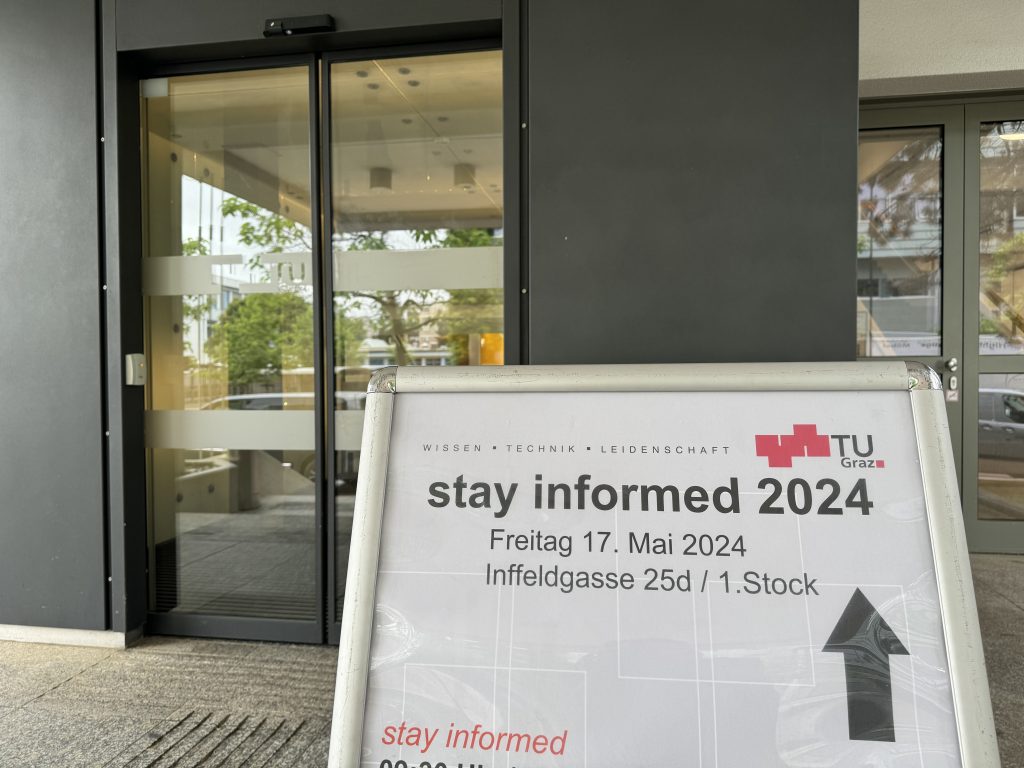I was able to take part in the information day “stay informed 2024”. This information-filled day, which took place on May 17, 2024, offered a variety of topics.


Photos: CC-BY-NC-ND 4.0 education.garden
One of the highlights of the morning was the guided tours of various institutes on the Inffeld campus. Here are some of the places we visited:
- Deep Learning for Vision and Graphics: The Institute for Machine Vision and Graphics presented applications of deep learning in image processing.
- Schumpeter Laboratory for Innovation: An inspiring place where innovative ideas and projects are brought to life.
StayINFORMEDonline #4: Artificial intelligence and its possibilities
The afternoon was dedicated to the topic of “Artificial intelligence and its possibilities”. Andrea Höginger, Vice-Rector for Research, opened the session with a speech followed by four presentations by experts:
Thomas Pock: “Artificial intelligence: opportunities and risks”
Thomas Pock, Head of the Institute for Machine Vision and Visualization, opened the lecture series with an overview of the developments and challenges of artificial intelligence (AI). He emphasized that the progress in the field of deep neural networks since 2012 has been remarkable, but also highlighted the risks and referred, among other things, to the text The Coming Technological Singularity: How to Survive in the Post-Human Era by Vernor Vinge:
- History of AI: He explained the historical waves of hype and disappointment in AI research.
- Technological breakthroughs: The breakthrough of deep learning and neural networks was particularly emphasized.
- Dangers and challenges: Pock pointed out that the control and further development of AI is mainly in the hands of large technology corporations, which can lead to dependencies.
- Future prospects: The need for new network architectures and limited development due to high costs were addressed.
Elisabeth Lex: “The Rise of Large Language Models”
Elisabeth Lex, Professor at the Institute of Interactive Systems and Data Science, focused on large language models and their importance:
- Definition and Function: what large language models (LLMs) are and how they work.
- History and development: The breakthrough of language models, especially through ChatGPT in 2022
- Technical details: technical aspects such as encoders and decoders and the challenges of processing large amounts of data.
- Application examples: how LLMs can be used in different areas and discussed their future development.
Gustav Oberdorfer: “AI-supported solutions for biotechnological and biomedical challenges of the 21st century”
Gustav Oberdorfer from the Institute of Biochemistry presented the application of AI in biotechnology and biomedicine:
- Biotechnological Applications: He showed how AI can help solve complex biotechnological problems.
- Future prospects: The potential future applications and integration of AI in biotechnological and biomedical research were highlighted. Also current developments in the field of AlphaFold3, which unfortunately is not open source.
Robert Peharz: “Probability and machine learning”
Robert Peharz from the Institute for Foundations of Information Processing dealt with the role of probability in machine learning:
- Probability Theory: Probability theory as a basis for machine learning.
- Human reasoning: Draw parallels between human and machine reasoning using probabilities.
- Application examples: Specific examples of how probabilistic methods are used in AI research.
- Future prospects: The relevance of these approaches for the further development of AI technologies.
These presentations provided a comprehensive overview of current developments and challenges in the field of artificial intelligence and their potential applications in various scientific disciplines.


Photos: CC-BY-NC-ND 4.0 education.garden
